Key takeaways:
- Ocean conservation is vital for biodiversity, human well-being, and mitigating climate change impacts.
- Challenges in marine waste management include diverse materials, lack of infrastructure, and public awareness issues.
- Community engagement and education are key strategies for fostering sustainable practices and collective action in conservation efforts.
- Measuring the impact on marine ecosystems through studies on biodiversity and pollution is essential for assessing the effectiveness of conservation initiatives.
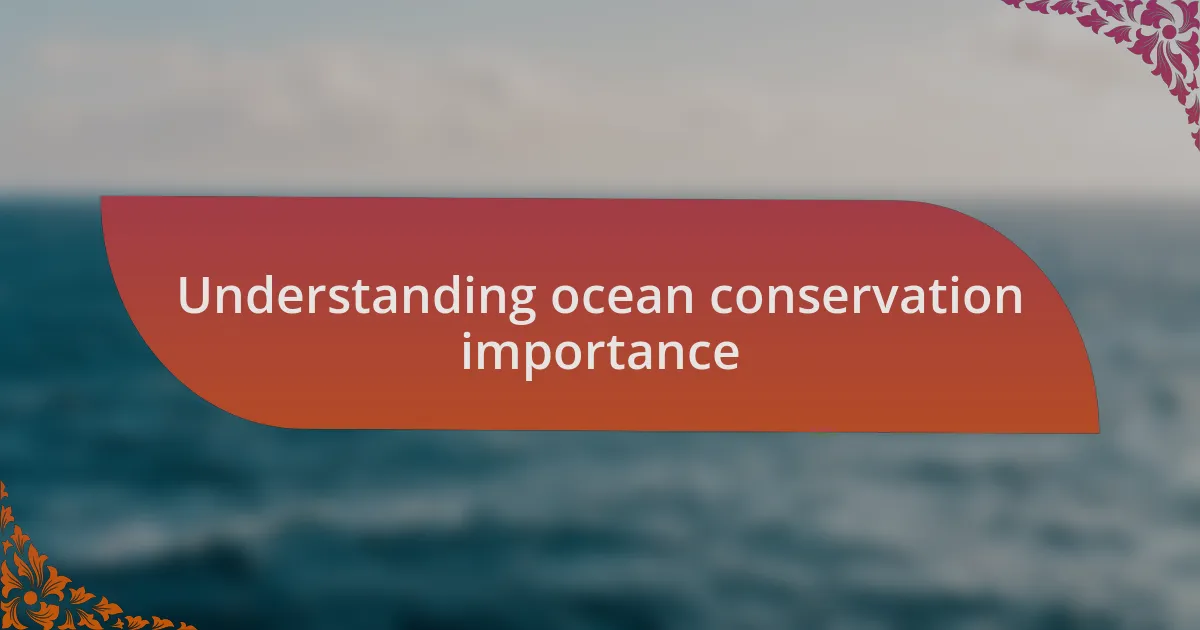
Understanding ocean conservation importance
Ocean conservation is crucial for maintaining the delicate balance of marine ecosystems that support life on our planet. I recall a day at the beach when I witnessed firsthand the impact of plastic waste on marine life. Watching a turtle struggle with a plastic straw stuck in its nostril was heart-wrenching; it made me realize just how interconnected our actions are with the health of ocean creatures.
Without healthy oceans, we risk not only the loss of biodiversity but also our own well-being. Think about it: oceans provide us with food, recreation, and even jobs. Sometimes, I find myself pondering whether we truly value these resources or take them for granted. The vibrant colors and sounds of a thriving coral reef can easily be overshadowed by the hum of the city life, yet they deserve our attention and respect.
Furthermore, protecting our oceans serves as a safeguard against climate change. I’ve seen the effects of rising sea levels and increased storm intensity in coastal communities. It compels me to ask, what kind of legacy are we leaving for future generations? By prioritizing ocean conservation, we not only enhance marine habitats but also fortify our own future against the looming crises of climate change.
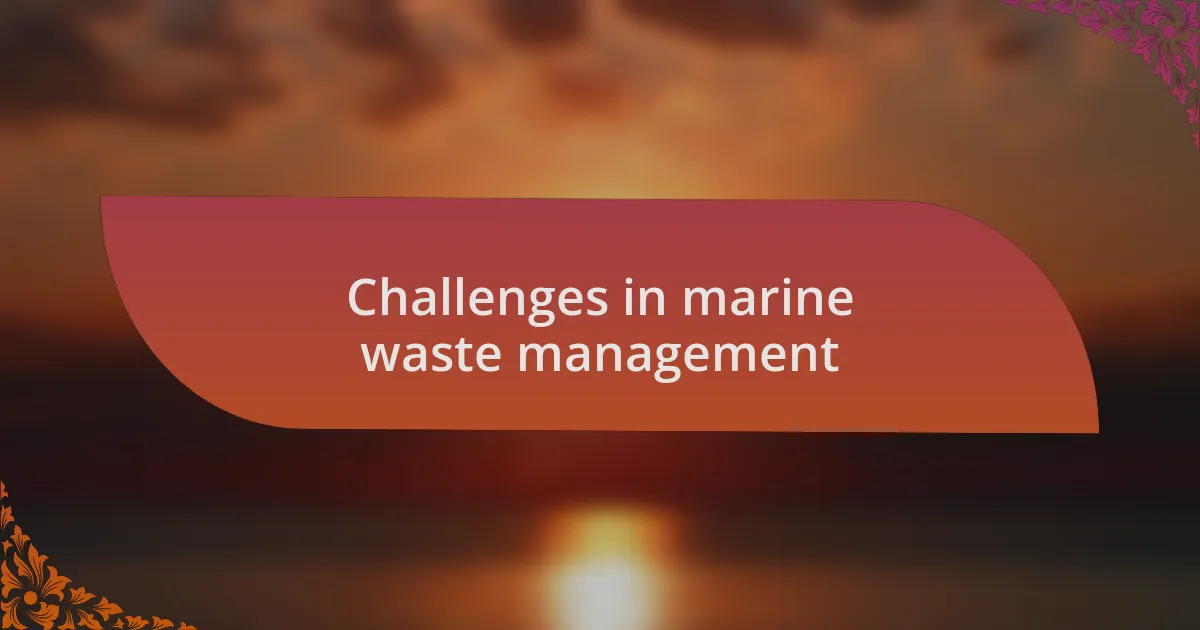
Challenges in marine waste management
Marine waste management faces significant hurdles that often go unnoticed. One major challenge is the sheer variety of materials that end up in our oceans. I can vividly recall volunteering for a beach cleanup and being astounded by the number of different items we collected — from fishing nets to microplastics. This variety complicates disposal and recycling efforts, as many materials require different methods and technologies to manage effectively.
Another concern is the lack of infrastructure in many coastal regions, especially in developing countries. I remember hearing stories from locals who desperately wanted to keep their shores clean but lacked the resources to do so. This creates a frustrating cycle where communities feel powerless against the tide of waste.
Public awareness and engagement also pose challenges. Many people remain oblivious to the impact their actions have on marine waste. I once had a conversation with a friend who casually tossed a plastic bottle into the ocean, believing it would “just float away.” It struck me how easily misinformation can propagate, highlighting the need for meaningful education and outreach efforts to inspire collective action.
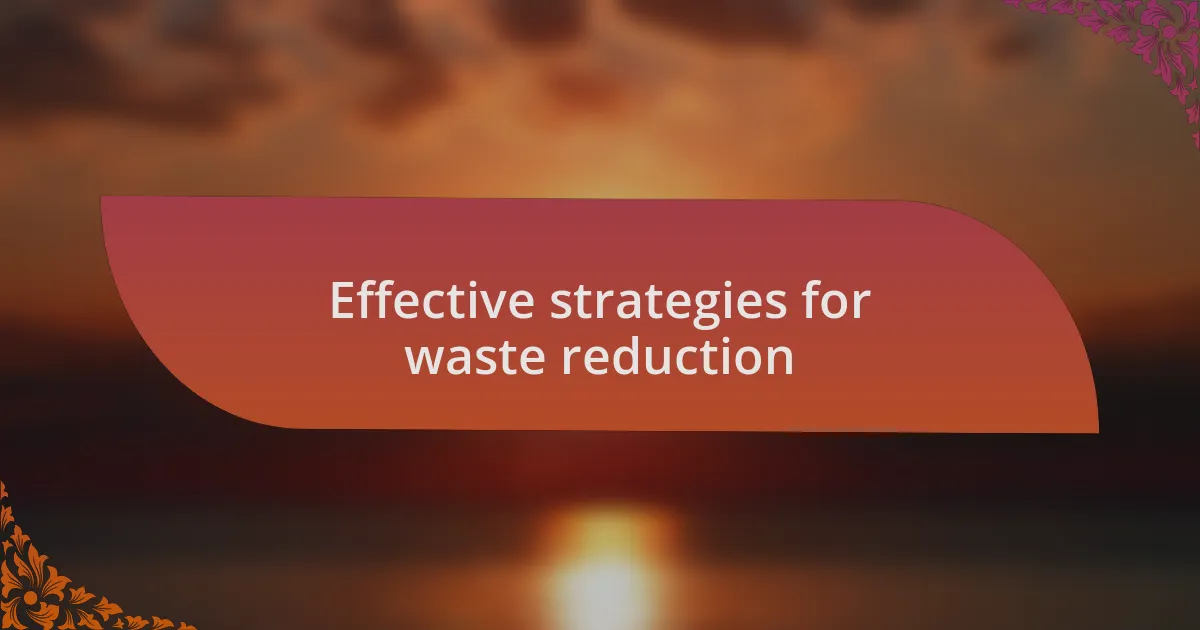
Effective strategies for waste reduction
One effective strategy for waste reduction is implementing community-based recycling programs. I was fortunate to witness a local initiative that transformed waste management in a small coastal town. Residents came together for regular workshops where they learned how to sort their waste properly. It was inspiring to see how this simple act fostered a sense of pride and ownership, as people realized their collective effort could significantly impact their environment.
Another approach worth considering is the promotion of sustainable alternatives to single-use plastics. I recall a pop-up market I visited where vendors exclusively offered biodegradable products. Conversations with the sellers revealed that many customers were eager to support eco-friendly practices but simply needed accessible options. This experience made me curious: why aren’t more communities embracing these sustainable alternatives?
Lastly, engaging in educational outreach can profoundly influence waste reduction efforts. I once joined a local group that organized school programs to teach children about marine ecosystems. The enthusiasm of those young minds as they learned about the ocean’s health made me realize how crucial early education is for fostering responsible habits. It’s eye-opening to consider that today’s youth will become the future stewards of our oceans.
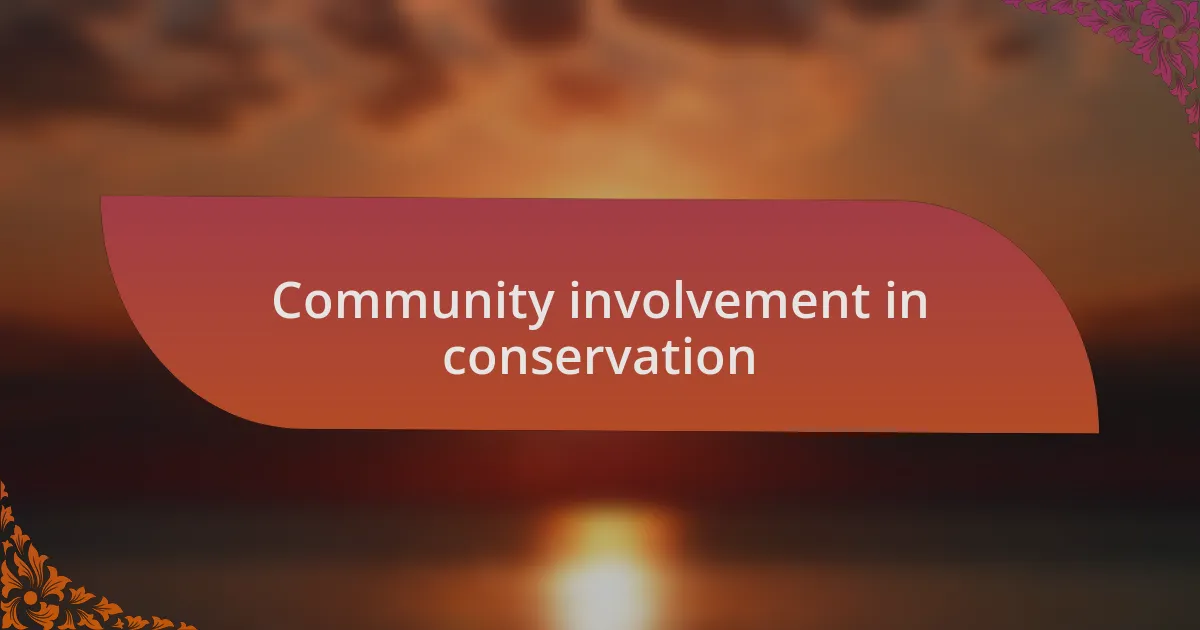
Community involvement in conservation
I believe that community involvement is at the heart of effective conservation efforts. During a beach cleanup I participated in, I noticed how diverse groups of people united for a common cause. It was as if the shared purpose created an unspoken bond among us, reminding me that each small action contributes to a larger impact. How often do we underestimate the power of collective action in transforming our local environments?
Furthermore, community organizations can play a pivotal role in mobilizing volunteers and resources for conservation initiatives. I remember volunteering with a local nonprofit that arranged monthly cleanups along our shoreline. The sense of camaraderie among participants generated excitement, and I felt a renewed commitment to protecting our oceans. It makes me wonder: can we harness this enthusiasm to inspire more sustainable practices beyond these events?
Finally, creating platforms for community dialogue around marine conservation can strengthen local commitment. When I shared my experiences on social media, I was pleasantly surprised by the flood of responses from friends wanting to get involved. Their willingness to engage in conversations about our ocean’s health reinforced my belief that knowledge shared among neighbors fosters responsibility and empowers everyone to take action. Isn’t it amazing how a simple conversation can ripple out, creating waves of change?
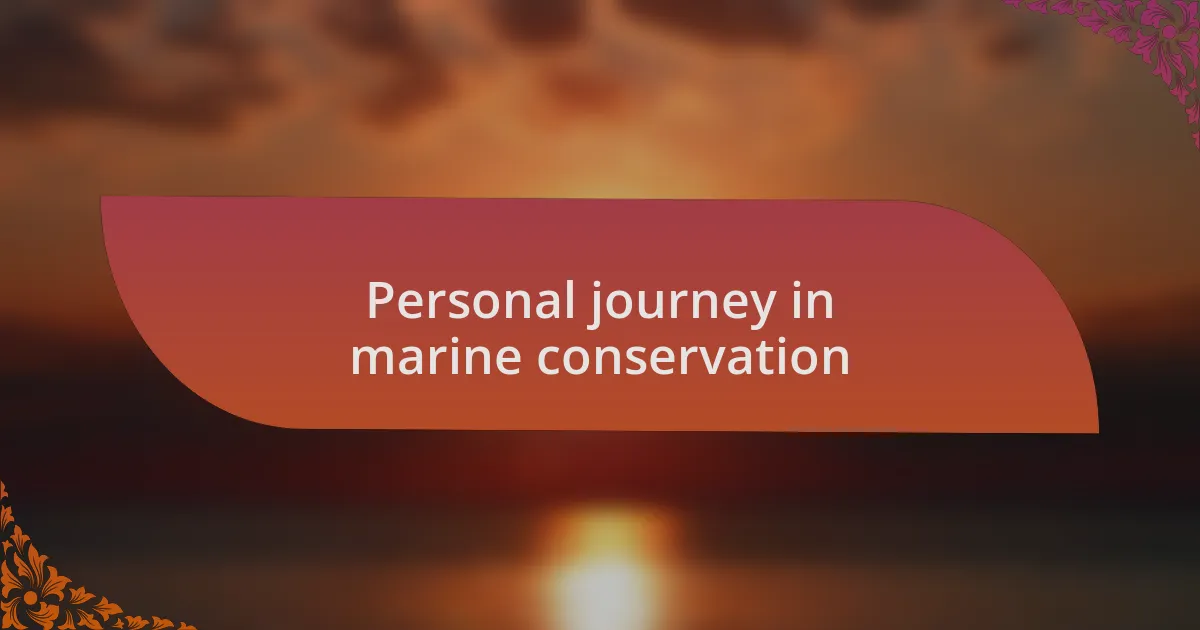
Personal journey in marine conservation
During my personal journey in marine conservation, I began to realize the profound connection I have with the ocean. I distinctly remember my first dive, surrounded by vibrant coral and curious fish. It was mesmerizing. But what struck me most was the stark contrast between the breathtaking beauty and the plastic debris swirling around us. It ignited something within me: a determination to protect this fragile ecosystem that feeds my soul. Have you ever felt the urge to act when confronted with something so beautiful yet threatened?
As I delved deeper into marine conservation work, I encountered countless stories of resilience and struggle. Once, I met a fisherman whose livelihood was affected by overfishing and pollution. Listening to his concerns, I understood that sustainable practices are not just about saving fish; they are about preserving communities and cultures. Can we truly separate our lives from the health of our oceans when so many depend on them?
The more I engaged with marine conservation, the clearer it became that education is vital. I remember hosting a workshop for local youths, teaching them about the impact of litter on marine life. Their curiosity shone through, and as they grasped the importance of their choices, I felt a surge of hope. Isn’t it remarkable how a conversation can plant seeds of change in the minds of the next generation? I believe that by nurturing this awareness, we can create a ripple effect that leads to stronger advocacy for our oceans.
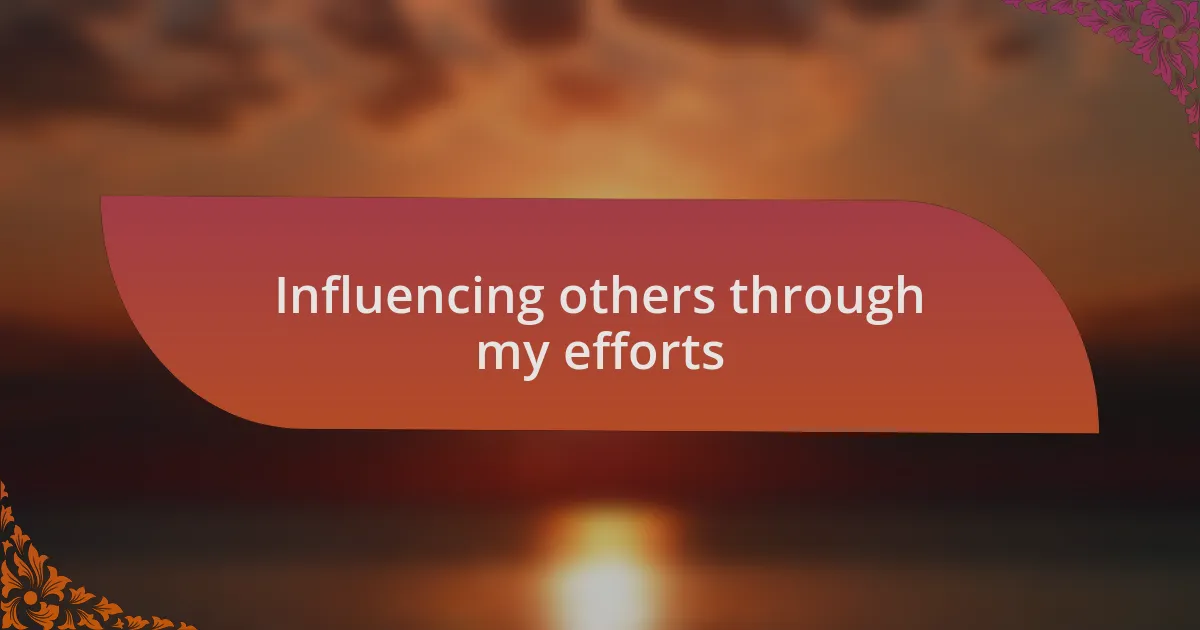
Influencing others through my efforts
Taking action in marine conservation has allowed me to influence others in unexpected ways. I recall volunteering at a beach cleanup where I met a group of students who were initially indifferent to waste management. As we worked side by side, picking up plastic debris and discarded fishing nets, I shared stories of how marine life suffers from our negligence. Watching their reactions transform—from boredom to genuine concern—gave me a sense of purpose. Isn’t it incredible how a shared experience can change perspectives?
My influence extends beyond one-on-one interactions. After organizing a community forum to discuss marine waste, I noticed a shift in local attitudes. Attendees shared their own experiences with ocean pollution, and together, we brainstormed practical solutions for reducing our plastic footprint. Witnessing this collective engagement was profoundly rewarding. Have you ever felt the power of community when everyone rallies around a common cause?
One of the most rewarding moments in my journey occurred during a school presentation where I shared my travels along polluted coastlines and pristine beaches. The room filled with students was silent, hanging on every word. At the end, one student approached me, asking how he could start his own cleanup initiatives. That simple question reignited my passion. Isn’t it fascinating how one conversation can inspire action that extends far beyond what we might expect?
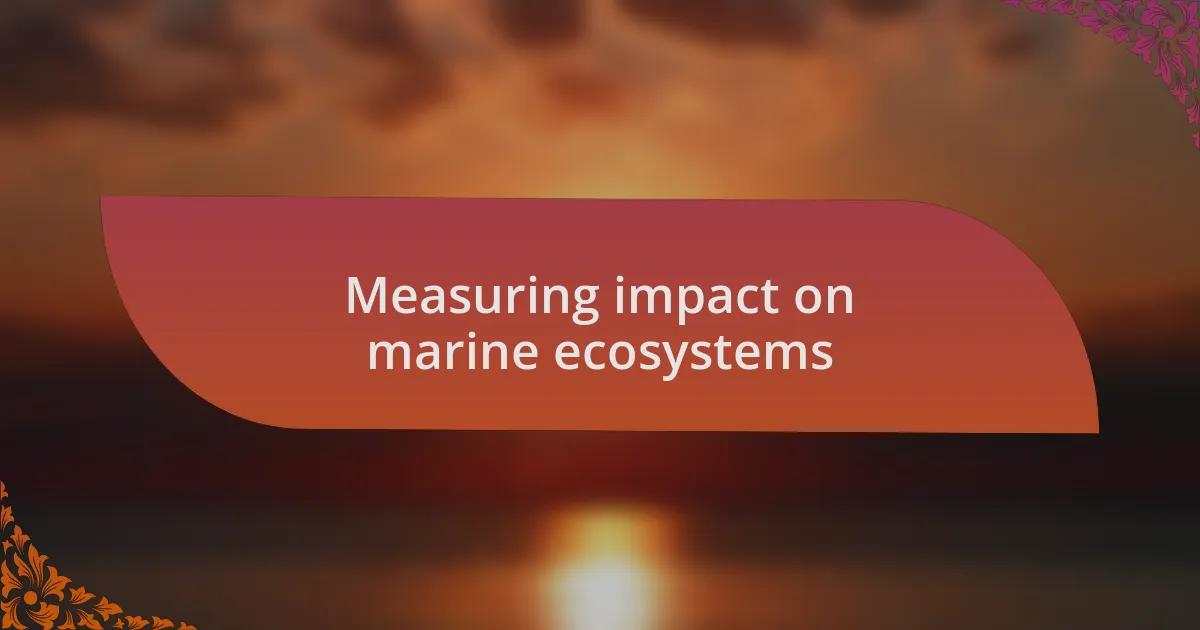
Measuring impact on marine ecosystems
Measuring the impact on marine ecosystems requires looking closely at various factors, such as water quality, biodiversity, and the presence of pollutants. I’ve participated in local studies where we monitored species populations before and after cleanup efforts, revealing surprising fluctuations. It’s humbling to realize that our actions can directly influence the vitality of marine habitats, isn’t it?
Another fascinating aspect I encountered was how sediment analysis can help us track long-term changes in coastal environments. During a project, I helped collect sediment samples, and the data showed a steady decrease in microplastics over a few years. This finding reinforced the idea that our efforts truly matter. Don’t you find it encouraging to see tangible results from our collective actions?
Furthermore, engaging with the local fishing community opened my eyes to their perspectives on ecosystem health. They shared stories of diminishing fish stocks and changing migration patterns, which starkly illustrated the interconnectedness of our actions and nature’s resilience. I left those conversations feeling both challenged and motivated. How do you measure the unseen effects of waste management on ocean life? Perhaps it’s a journey of understanding that leads to a deeper commitment to conservation.